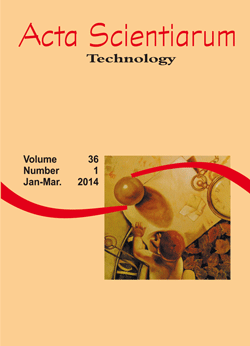<b>Vibration levels on rear and front axles of a tractor in agricultural operations</b> - doi: 10.4025/actascitechnol.v36i1.18170
DOI:
https://doi.org/10.4025/actascitechnol.v36i1.18170Keywords:
tillage operations, mechanical vibrations, forward speedAbstract
Excessive vibrations in agricultural tractors can contribute with mechanical failures and subject the operator to discomfort. This work evaluated the vibration levels on rear and front axles of an agricultural tractor working at different forward speeds and wheel drive conditions in plowing and harrowing operations. Field tests were carried out in a completely randomized design in a factorial arrangement 3 x 2 (forward travel speeds x front-wheel-assist enable or disable), with three replications. Tractor vibration was measured using two single axis accelerometers fixed above the rear and front axles. The actual forward speed of the tractor was obtained by means of ultrasonic radar and the angular velocity of the wheels was measured with magnetic transducers. The drawbar force to pull the disc harrow was obtained by a load cell. The results showed that the vibration levels observed for the plowing operation were higher than observed for the harrowing operation. When the front-wheel-assist (FWA) was enabled there was a reduction in vertical vibration levels of the tractor axles. The highest vibration levels were observed in the frequency range of 2 to 4Hz for the both soil tillage operations evaluated
Â
Â
Downloads
Downloads
Published
How to Cite
Issue
Section
License
DECLARATION OF ORIGINALITY AND COPYRIGHTS
I Declare that current article is original and has not been submitted for publication, in part or in whole, to any other national or international journal.
The copyrights belong exclusively to the authors. Published content is licensed under Creative Commons Attribution 4.0 (CC BY 4.0) guidelines, which allows sharing (copy and distribution of the material in any medium or format) and adaptation (remix, transform, and build upon the material) for any purpose, even commercially, under the terms of attribution.
Read this link for further information on how to use CC BY 4.0 properly.











8.png)




